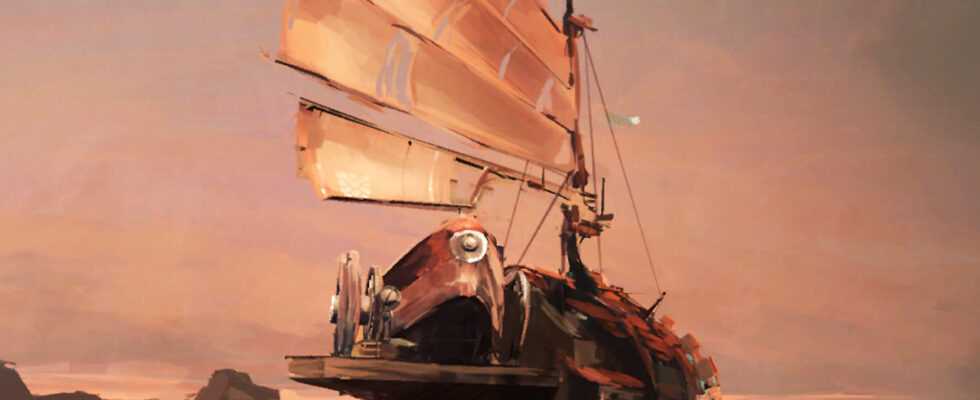If the FAR series doesn’t tell you anything, you’ve probably missed something. Released in 2019, Far Lone Sail was talked about for its artistic direction to die for, with this rendering all in watercolor, and a story told without the slightest word, just through music and images. In 2022, the Swiss studio Okomotive is back with Far: Changing Tides, a new horizontal scrolling adventure that will abandon the rolling machine of the first opus and take us to face the waves. A sequel all in poetry? That’s what we’re going to see.
Still in horizontal scrolling to the right, Far: Changing Tides does not reinvent the recipe created in 2019 by the Okomotive studio. We go through a minimalist intro that explains the controls, and we start our adventure just as dry. Our character is nothing like a superhero, and his movements are limited to four directions, plus a jump. The longer the button is held, the higher he can jump, but his small size does not allow him incredible prowess. Facing his house ravaged by the waves, our hero has no choice but to set off on an adventure at the helm of a new machine of generous proportions. Without having the look of a boat, our ship (which looks like a big barrel) will require a lot of investment in order to be able to move.
As in the first episode, many blue buttons are placed everywhere in the structures, and you will have to learn how to use them in order to progress in the adventure. A button will allow us to raise the mast, while we will have to get a halyard at its top, then attach it to the deck in order to hoist the sails. At this time, new controllers will appear in order to be able to adjust our sails, and thus manage our speed according to the wind and its direction (a bit like in Sea of Thieves). As with the Far Lone Sail vehicle, we will also improve our ship as the adventure progresses.
Heat Marcel!
For example, we will be able to add an engine to it to move forward when the trade winds are too calm, provided that we have collected enough to supply the boiler with fuel. It will therefore be necessary to hang crates and boxes collected outside on the hooks of a boiler supply system located in the hold. Then, on the first floor, a first button will take care of lighting the fire, while we will have to jump on a blower to fan the flames. Once the pressure is sufficient, it will be necessary to go even higher to maneuver the levers which operate the motors, with three speeds forwards, one backwards and a neutral. Running under the engine will therefore not be an easy task as it requires numerous interactions located at the four corners of the ship, not to mention fuel management.

The ship becomes in passing a protagonist in its own right which we will have to take care of. The boiler can overheat (it will have to be cooled by spraying it with water), while collisions can damage various elements. It will then be necessary to have a soldering iron charged in order to be able to repair the damage, and to maintain our functional boat. Inevitably, if these tasks are rather well thought out, they can become redundant, and bore the player who expects something other than a somewhat contemplative journey.
Far Changing Tides: in vogue?
The big novelty of FAR: Changing Tides is above all to offer us a game that allows more verticality, and freedom, with the possibility of exploring the seabed. Our character will quickly be equipped with a spacesuit with a kind of propeller to move faster underwater, and as the adventure progresses, our ship will also gain the ability to operate as a sub- marine. All this will obviously serve to get rid of the many pitfalls that will be on our way. Because yes, apart from navigation, the game will often put us in front of a small problem to solve. We will therefore explore various and varied structures (from the sunken city to the shipyard in ruins) in order to be able to clear the way, which therefore transforms the gameplay into a platform game tinged with puzzle-game elements.

Don’t expect to face a devious difficulty, here everything is very simple, and each puzzle can be understood in just a few moments, the objective being to immerse the player in an atmosphere, and make him experience a journey, more than to give him a challenge. This poetic side is precisely one of the great strengths of the game which displays an artistic direction to die for, with this super attractive watercolor style. The sets are incredibly beautiful, and the image replaces the words to make us live a real adventure where we go from discovery to discovery in order to understand the universe in which we find ourselves immersed. The visual aspect is also supported by a hyper-worked soundtrack that perfectly dresses the whole thing. We go from soft and melodious musical themes to much more minimalist music depending on the mood, while when things get tough, the soundtrack intensifies.

The adventure remains brief with about 7 hours to reach the end of what looks like a nice trip, and of course, the replay value is close to nil. Nevertheless, it remains much longer than was Far: Lone Sail which we could complete in less than 4 hours. Moreover, thanks to the evolutions that we bring to our boat, the gameplay is renewed periodically as the adventure progresses and gains in complexity, since it will be necessary to call on the more and more numerous possibilities offered by our vehicle. .
